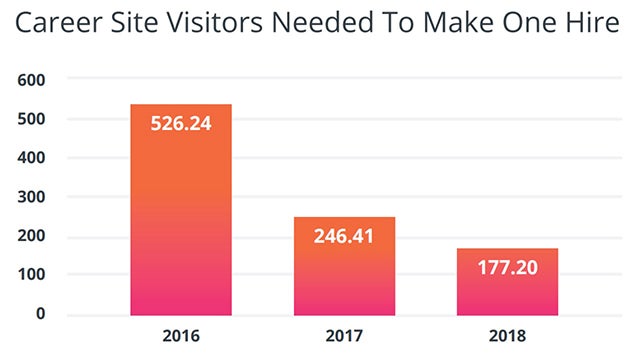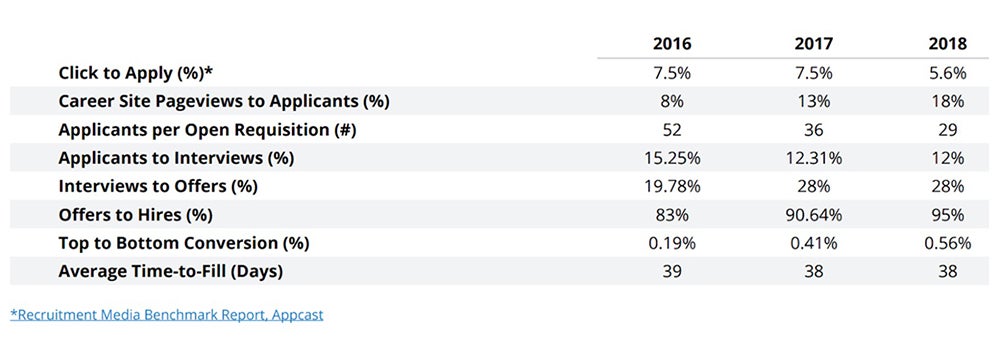2019 Recruiting Benchmark Report: Your Guide to Finding Top Talent
You can’t have a conversation about recruiting without talking about the so-called ‘talent war.’
Industry reports suggest that we are in a state of full employment and that the talent war is fierce. The economy is growing, with U.S. job growth surging in January 2019 and employers hiring the most workers in 11 months.
But as we take a closer look at the market, that’s not the only way to look at the state of the industry. There’s a counter argument to conventional wisdom: Is talent really that hard to find?
A Different Perspective on the Labor Market
In looking at the trends impacting this year’s Recruiting Benchmark Report, we realized that there is likely more available talent than is immediately obvious. Based on the U.S. Bureau of Labor Statistics, “those with temporary, part-time or full-time jobs are considered employed” and excluded from the unemployment metric. But that’s misleading. There has been a 42% increase in the number of ‘involuntary’ (meaning they can’t find a full-time job) workers in the U.S. and including these part-timers skews the unemployment number lower. Should they really be considered employed? Some high-skilled workers become part-time by choice, but some are not and are still seeking full-time employment.
On top of that, wages are flat. As unemployment goes down, ‘real wages’ (wages adjusted for inflation) are no longer going up. This may be due in part to the gig economy—where ‘involuntary’ part-time work is high—which has broken this fundamental link in capitalism. If unemployment was truly so low overtime, wages would go up; but that’s not the case.
Our hypothesis here is that there are more than enough capable, unemployed Americans who can do the work—including veterans, STEM graduates, mothers returning to work, 50-somethings, displaced blue collar workers, and even those ‘involuntary’ workers eager for better pay and benefits. Instead of paying a premium for the limited supply of qualified talent, companies can invest in training and development for these motivated populations.
New Recruiting Data Now Available
Topics like this form the centerpiece of our fourth annual Recruiting Benchmark Report, out this week. Based on exclusive data from 10M applications and 50M job seekers, the report gives you the hard numbers and expert analysis needed to find the sweet spots in the recruiting funnel and improve funnel efficiency.
Here’s a snapshot view of how the funnel has changed over the last three years:
The annual report has become the gold standard for insight into the recruiting industry, and for good reason. It’s a valuable resource to understand how your own numbers compare to other organizations in your specific industry and geography, and will help you shine a light on recruiting funnel leakages.
This year I’m particularly excited about new data, including the most efficient source of hiring and new sources of hiring, as well as the number of career website visitors and candidates you need to make one hire. And maybe most importantly, we feature actionable advice—learnings you can take back to the organization and put into practice right away.
Where can I have the biggest impact on the organization? How can I improve our recruitment marketing and conversion rates throughout the funnel? What trends are on the horizon that I need to prepare for? Answers to those questions and more are included in the report.
2018 Was a Talent Tipping Point
One of the biggest reveals in this year’s report is that companies needed fewer career website visitors and fewer overall candidates to make one hire.

Why? Because recruiters have become more efficient.
Compared to 2017, the number of career website visitors, candidates, and open jobs all grew in 2018. However, the number of open jobs significantly exceeded the number of candidates—revealing a tipping point of sorts. Within this environment, recruiters have learned to be more efficient. They’re optimizing the funnel to find quality hires among a smaller pool of candidates.
It’s this efficiency—combined with resourcefulness and creativity—that will give some recruiters competitive advantage in the months and years ahead.
Those organizations who get creative, search for candidates beyond the resume, and invest in training will come out ahead.
The recruiting industry is changing quickly. From AI and automation, to conversational recruiting, to concerns over an imminent economic downturn, there’s a slew of factors impacting how you do your job on a daily basis. We want this report to be a resource to you as you navigate these changes—a way to help you keep up with the latest trends in recruiting, increase funnel efficiency, and establish credibility to get the resources you need. Our goal is to deliver quantifiable data and tactical advice you need to measure where you are, where you’re going, and set a course for how to get there.
Ready to get started?
Recruiting—when done well—is all about conversations. And I’d love to hear from you. Share your experiences on Twitter: @jobvite #recruitingbenchmarks, or contact me directly at ronen@jobvite-inc.com.

